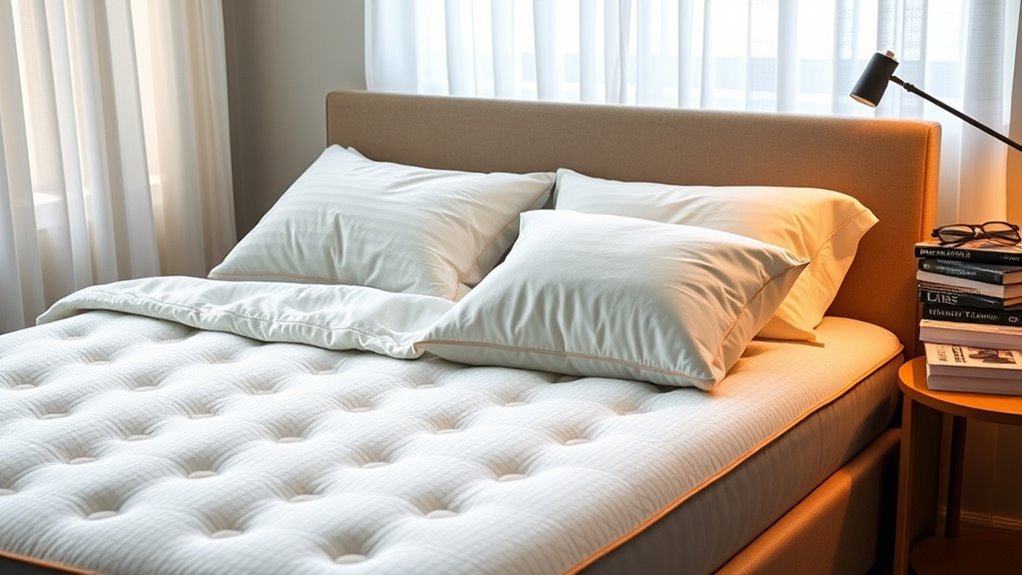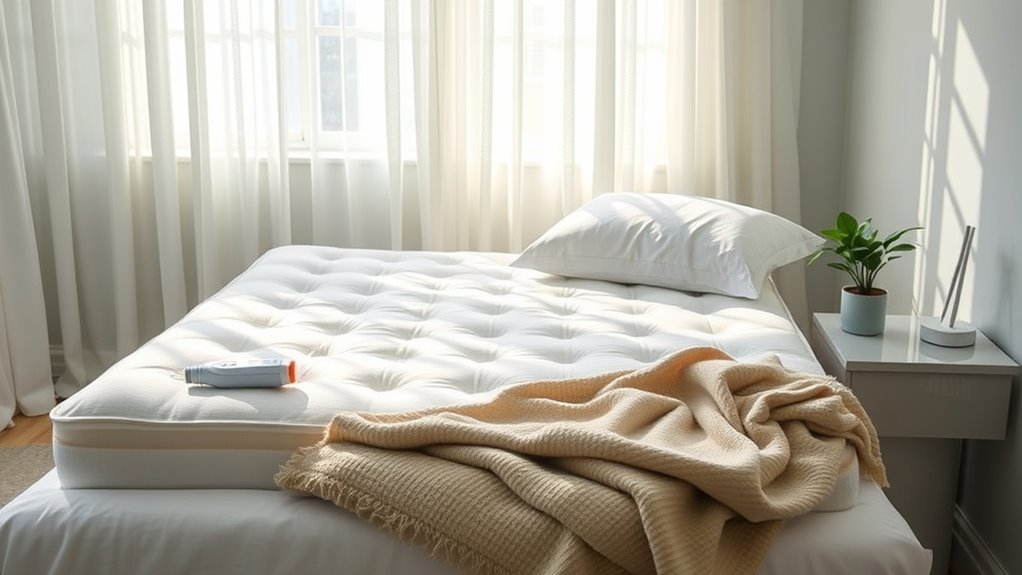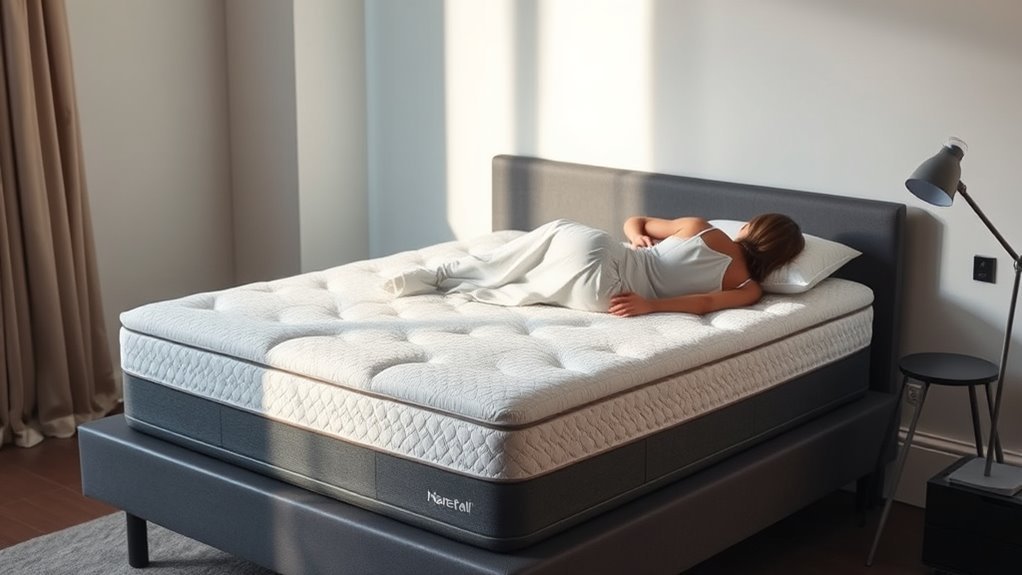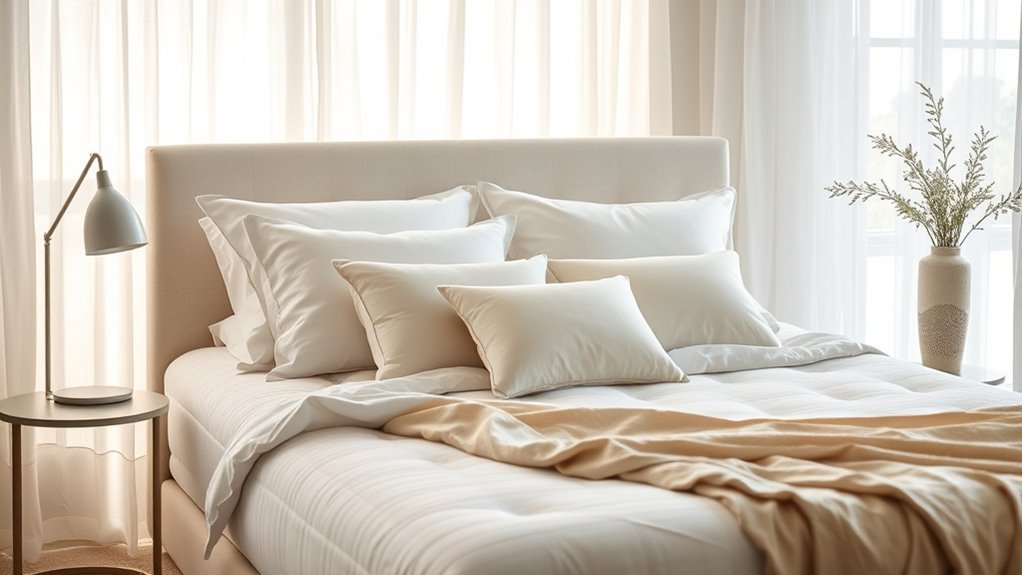Choosing a mattress for combination sleepers with asthma is vital for your comfort and respiratory health. Look for a medium to medium-firm mattress that offers support across various sleep positions. Materials like memory foam or latex can help reduce allergens and improve airflow. Opt for hypoallergenic features and consider a trial period to guarantee the mattress suits your needs. Maintaining a clean sleep environment is fundamental too, and there’s more to explore for ideal choices.
Understanding Combination Sleepers

When it comes to sleep, understanding the unique needs of combination sleepers is crucial. If you tend to switch positions throughout the night, you know how important it is to find the right mattress. Your sleep patterns can change, often moving between your back, side, and stomach. Each position requires different support levels, which means your mattress must be adaptable. This flexibility helps prevent discomfort and promotes restful sleep. You want a mattress that responds to your movements, offering both comfort and support. By focusing on the right materials and construction, you can enhance your combination sleep experience, giving you the freedom to find the perfect position without waking up feeling restricted or sore.
Importance of Mattress Support

Choosing the right mattress support is vital, especially for combination sleepers with asthma, as it directly impacts your comfort and overall sleep quality. A supportive mattress helps maintain proper spinal alignment, reducing pressure points and allowing you to move freely without discomfort. This is important for your sleep hygiene, as a well-supported mattress can minimize allergens and promote a healthier sleeping environment. Additionally, consider mattress durability; you want something that’ll withstand your movements over time without sagging. This guarantees you get the most out of your investment, providing consistent support for years to come. Remember, the right mattress support not only enhances your sleep experience but also contributes to your overall well-being as you navigate your asthma symptoms.
Comfort Levels for Different Sleep Positions

When you sleep in different positions, your mattress needs to cater to those specific requirements for comfort and support. Side sleepers often need softer materials to cushion their shoulders and hips, while back sleepers typically benefit from firmer support to maintain spinal alignment. Understanding these needs can help you choose a mattress that promotes better sleep quality, especially if you have asthma.
Side Sleepers’ Needs
Although side sleepers often enjoy the comfort of cradled support, their specific needs can differ greatly based on their body type and any underlying conditions, such as asthma. To create an ideal sleep environment, focus on a mattress that offers both softness and support to align your spine. A medium to medium-firm mattress is often perfect. Your pillow choice is also essential; it should fill the gap between your head and shoulders to maintain proper alignment. Consider hypoallergenic materials to minimize asthma triggers. Additionally, guarantee your bedding is breathable and easy to clean. By addressing these elements, you can enhance your sleep quality and truly enjoy the freedom of restful nights despite asthma.
Back Sleepers’ Support
While side sleepers benefit from mattresses that cradle their bodies, back sleepers have different requirements for ideal support and comfort. You need a mattress that promotes proper spinal alignment and provides adequate lumbar support to guarantee a restful night. Look for options that offer a medium-firm feel, as this helps distribute your weight evenly without sinking too deeply. Materials like memory foam or hybrid designs can contour to your body while maintaining the necessary support. It’s essential to find a mattress that adapts to your shape, keeping your spine in a neutral position. This way, you’ll wake up feeling refreshed and free from discomfort, ready to tackle the day ahead without the burden of poor sleep.
Materials That Reduce Allergens
When choosing a mattress, consider materials that actively reduce allergens to help manage your asthma symptoms. Hypoallergenic mattresses, along with dust mite-resistant features and breathable fabrics, can create a healthier sleep environment. It’s important to prioritize these options to guarantee a more comfortable night’s rest.
Hypoallergenic Mattress Materials
If you’re a combination sleeper with asthma, selecting a mattress made from hypoallergenic materials can greatly improve your sleep environment. Look for options like latex or memory foam, which resist dust mites and mold, helping you breathe easier. Pair your mattress with hypoallergenic pillows to maintain a consistent allergen-free zone. Additionally, consider using mattress encasements that provide an extra layer of protection against allergens, ensuring your sleep space remains clean and safe. These materials not only enhance comfort but also support your respiratory health, giving you the freedom to move throughout the night without worrying about triggering asthma symptoms. Investing in hypoallergenic materials is a proactive step towards a restful night’s sleep and better overall well-being.
Dust Mite Resistance
Choosing materials that resist dust mites is essential for combination sleepers with asthma, as these tiny pests can exacerbate respiratory issues. Look for mattresses designed with dust mite control in mind; materials like latex and memory foam often provide a barrier against allergens. These options not only enhance comfort but also contribute to allergen reduction.
Consider encasement covers for your mattress and pillows, which can effectively block dust mites from settling in. Regularly washing bedding in hot water also helps maintain a healthy sleeping environment. By prioritizing dust mite resistance, you can create a sanctuary that supports your freedom to breathe easily and sleep soundly, regardless of your sleep position.
Breathable Fabric Options
While finding the right mattress is essential for a good night’s sleep, selecting breathable fabric options can greatly enhance your comfort and respiratory health, especially if you have asthma. Choosing mattresses made with breathable materials helps reduce allergens while promoting airflow. Look for models that feature cooling technologies, as these can keep you comfortable throughout the night.
Here’s a quick comparison of breathable fabric options:
| Material | Benefits |
|---|---|
| Organic Cotton | Soft, hypoallergenic, and moisture-wicking |
| Bamboo | Naturally breathable and antimicrobial |
| Tencel | Eco-friendly, soothing, and thermoregulating |
| Latex | Durable, breathable, and resistant to dust mites |
Enhancing Airflow for Better Breathing
To guarantee you get a good night’s sleep despite asthma, enhancing airflow in your mattress is essential. A well-ventilated mattress promotes better air circulation, creating a sleep environment that supports your breathing. Look for mattresses made from materials like latex or gel-infused memory foam, as they naturally allow air to flow more freely than traditional foams. Additionally, consider models with breathable covers that wick away moisture, further improving airflow. Elevating your mattress slightly can also aid in ventilation, giving your body the freedom to breathe easily. By prioritizing airflow, you not only create a more comfortable sleep environment but also help reduce asthma triggers, empowering you to enjoy restful nights without worry.
Evaluating Firmness Preferences
Finding the right firmness level for your mattress can greatly impact your sleep quality, especially as a combination sleeper with asthma. You’ll want a balance that supports your body while accommodating your changing positions throughout the night. Consider your personal preferences regarding comfort and support. Here’s a quick guide to help you evaluate firmness options:
| Firmness Level | Ideal For |
|---|---|
| Soft | Side sleepers, pressure relief |
| Medium | Combination sleepers |
| Medium-Firm | Back sleepers |
| Firm | Stomach sleepers |
| Adjustable | Customizable comfort |
Trial Periods and Return Policies
When selecting a mattress, it’s essential to take into account trial periods and return policies, especially for combination sleepers with asthma. These features provide you with the flexibility to find what truly works for you. Here are some key points to reflect on:
- Trial Period Length: Look for a trial period of at least 90 nights to allow enough time for adjustment.
- Return Process: Understand the steps required if you need to return the mattress.
- Customer Feedback: Read reviews to see how others felt about the process.
- Mattress Warranties: Verify the warranty covers defects, giving you peace of mind.
Maintenance Tips for Asthma-Friendly Mattresses
Maintaining an asthma-friendly mattress is essential for ensuring a restful night’s sleep, especially for combination sleepers. Regular mattress cleaning is key; vacuum your mattress monthly to remove dust and allergens. Consider using a hypoallergenic cover for added allergen protection, as it can act as a barrier against dust mites and mold. Wash your mattress cover and bedding weekly in hot water to eliminate any potential irritants. If spills occur, clean them immediately to prevent moisture buildup, which can trigger asthma symptoms. Finally, rotate your mattress every few months to promote even wear and prolong its lifespan. By following these simple maintenance tips, you can create a healthier sleep environment that supports your asthma management and overall well-being.
Frequently Asked Questions
Can Mattress Type Influence Asthma Symptoms During Sleep?
Yes, the type of mattress you choose can considerably influence your asthma symptoms during sleep. Just like a well-tailored suit, a mattress should fit your needs. Opt for allergy-resistant options, such as memory foam or latex, which can help reduce dust mites and other irritants. The right mattress materials can create a comfortable haven, allowing you to breathe easy and wake up refreshed, embracing the freedom of a good night’s sleep.
Are There Specific Brands Recommended for Asthma Sufferers?
Yes, certain mattress brands are better suited for asthma sufferers. Look for materials like organic latex or memory foam, which can reduce allergens. Brands like Saatva and Avocado offer eco-friendly options that prioritize breathability and hypoallergenic properties. When comparing brands, consider those with certifications like CertiPUR-US or GREENGUARD Gold. It’s crucial to find a mattress that not only supports your sleep style but also promotes a healthier sleeping environment.
How Often Should I Replace My Mattress if I Have Asthma?
You should replace your mattress every 7 to 10 years if you have asthma. Over time, mattresses can accumulate dust mites, mold, and other allergy triggers that worsen your symptoms. Regularly updating your mattress helps guarantee a healthier sleep environment. Consider factors like mattress lifespan and materials that resist allergens to enhance your comfort and well-being. By prioritizing your sleep space, you’re taking an essential step towards better health and freedom from asthma-related issues.
Do Mattress Protectors Help With Asthma-Related Allergens?
Yes, mattress protectors can definitely help with asthma-related allergens. They act as allergen barriers, keeping dust mites and other irritants at bay. A high-quality protector can greatly reduce your exposure to these triggers, allowing you to breathe easier at night. Just make sure it’s breathable and washable to maintain a clean sleeping environment. By investing in a good mattress protector, you’ll take an essential step toward better sleep and improved health.
Can Sleep Position Affect My Asthma During the Night?
Yes, your sleep position can definitely affect your asthma during the night. Sleeping on your back might worsen symptoms by restricting airflow, while side sleeping often promotes better respiratory health. If you’re a stomach sleeper, you may experience pressure on your chest, which can also hinder breathing. Finding a comfortable position that allows for open airways is essential. Experiment with different positions to see what helps you breathe easier while you sleep.



